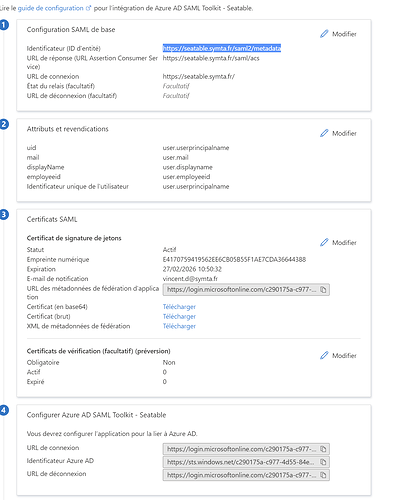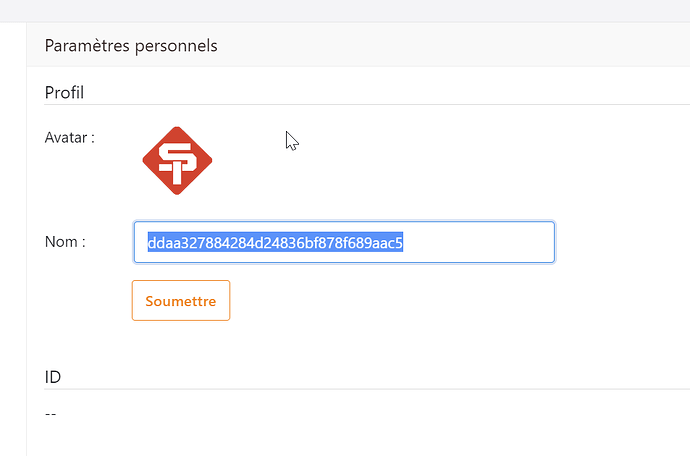Hello, try to configure the SAML SSO with Azur active directory.
I have this error !
FileNotFoundError: [Errno 2] No such file or directory: ‘/opt/seatable/seatable-server-latest/dtable-web/seahub/saml/attribute-maps’
Can oyu help me ?
Thanks
2023-02-27 13:33:56,974 [ERROR] django.request:230 log_response Internal Server Error: /saml2/metadata/
Traceback (most recent call last):
File “/opt/seatable/seatable-server-latest/dtable-web/thirdpart/django/core/handlers/exception.py”, line 47, in inner
response = get_response(request)
File “/opt/seatable/seatable-server-latest/dtable-web/thirdpart/django/core/handlers/base.py”, line 181, in _get_response
response = wrapped_callback(request, *callback_args, **callback_kwargs)
File “/opt/seatable/seatable-server-latest/dtable-web/thirdpart/django/views/generic/base.py”, line 70, in view
return self.dispatch(request, *args, **kwargs)
File “/opt/seatable/seatable-server-latest/dtable-web/thirdpart/django/views/generic/base.py”, line 98, in dispatch
return handler(request, *args, **kwargs)
File “/opt/seatable/seatable-server-latest/dtable-web/thirdpart/djangosaml2/views.py”, line 822, in get
conf = self.get_sp_config(request)
File “/opt/seatable/seatable-server-latest/dtable-web/thirdpart/djangosaml2/views.py”, line 100, in get_sp_config
return get_config(self.get_config_loader_path(request), request)
File “/opt/seatable/seatable-server-latest/dtable-web/thirdpart/djangosaml2/conf.py”, line 71, in get_config
return config_loader(request)
File “/opt/seatable/seatable-server-latest/dtable-web/thirdpart/djangosaml2/conf.py”, line 48, in config_settings_loader
conf.load(copy.deepcopy(settings.SAML_CONFIG))
File “/opt/seatable/seatable-server-latest/dtable-web/thirdpart/saml2/config.py”, line 338, in load
self.load_complex(cnf)
File “/opt/seatable/seatable-server-latest/dtable-web/thirdpart/saml2/config.py”, line 266, in load_complex
acs = ac_factory(cnf.get(“attribute_map_dir”))
File “/opt/seatable/seatable-server-latest/dtable-web/thirdpart/saml2/attribute_converter.py”, line 62, in ac_factory
for fil in sorted(os.listdir(path)):
FileNotFoundError: [Errno 2] No such file or directory: ‘/opt/seatable/seatable-server-latest/dtable-web/seahub/saml/attribute-maps’
2023-02-27 13:35:24,923 [ERROR] seahub.saml.views:52 _decorated SAML relevant settings invalid.
2023-02-27 13:35:24,923 [ERROR] seahub.saml.views:53 _decorated SAML_METADATA_LOCAL_FILE:
2023-02-27 13:35:24,923 [ERROR] seahub.saml.views:54 _decorated SAML_METADATA_REMOTE_URL:
2023-02-27 13:35:24,923 [ERROR] seahub.saml.views:55 _decorated SAML_PROVIDER_DOMAIN: azure.saml
2023-02-27 13:35:24,923 [ERROR] seahub.saml.views:56 _decorated SAML_ATTRIBUTE_MAP: {‘uid’: ‘uid’, ‘mail’: ‘contact_email’, ‘name’: ‘name’, ‘employeeid’: ‘employee_id’, ‘jobtitle’: ‘user_role’}
2023-02-27 13:35:24,923 [ERROR] seahub.saml.views:57 _decorated ENTITY_ID:



